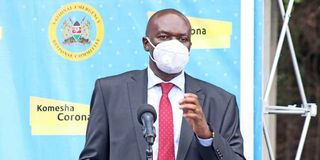Ministry rules out mass target Covid-19 testing in new strategy

Health Service Director General Dr Patrick Amoth giving daily briefs on Covid-19 at Afya House, Nairobi on Monday, June 22, 2020. PHOTO | DENNIS ONSONGO | NATION MEDIA GROUP
What you need to know:
- In a draft document under discussion, the country will now be testing only those with symptoms and in quarantine centers and only those who exhibit the symptoms.
Among the reasons for making the target largely unachievable is the limited number of testing kits and testing capacities in the private and government-owned laboratories.
In a new Covid -19 testing strategy being developed by the Ministry of Health, there will be no mass target testing in the country, this is even as the country clicked 100 days since the virus was detected.
This was arrived at after it emerged that in most of the areas that the government conducted mass testing, very few Kenyans turned positive and this led to wastage of testing reagents which have been in shortage for months now.
In a draft document under discussion, the country will now be testing only those with symptoms and in quarantine centers and only those who exhibit the symptoms.
This even has 80 per cent of those infected are asymptomatic, they are not showing any symptoms, an indication that the virus is in the community and the testing is not vigorous.
EXPENSIVE TEST
“We have been doing well when it comes to testing but testing everyone who turns up for the test is very expensive For instance, Out of 100 people in a target mass testing only 10 can be positive that means that the reagents used in testing the remaining 90 have been wasted. If we concentrate on those with symptoms, at least the number of the positive cases are high,” Dr Patrick Amoth, Health director-general.
As many suggest that mass target testing would allow for more cases to be reported, Dr Amoth said, this is not viable in middle-income countries since the cost of conducting the exercise is high, the technology involved is wanting and more expertise needed which Kenya is still struggling to have. The strategy being developed by the National Covid-19 Task Force chaired by Principal Secretary Susan Mochache was presented last week on Thursday for final input.
Globally, most countries are struggling to purchase the testing reagents and by this, Kenya has come up with its own strategy that would match the number of kits that they have.
“What we will do is to spread and plan with the reagents that we have. Spread them so that we do not run out of the kits,” Dr Amoth said. This is even as the country increases its testing capacity with the number of infections rising steadily.
In April, Health Cabinet Secretary Mutahi Kagwe in his projection had said that the government was planning to test about 250,000 samples by June, the country is shy of the target by about 100,000 samples.
Among the reasons for making the target largely unachievable is the limited number of testing kits and testing capacities in the private and government-owned laboratories.
LAXITY
The largest ever tested since the first case was recorded in March 13 is about 6,000 and the tests have been rising steadily. Cumulatively, 140,012 tests have been done so far. This even as the ministry announced that the public testing facilities had the capacity to test 35,000 samples a day.
Monday, Mr Kagwe, who announced how the country had progressed month by month, said that in March 3,419 samples were tested out of which 78 were positive. It increased to 19,108 samples tested, and 328 tested positive.
In May 57,527 samples tested with 1,615 turning out positive and as of June, 59,958 samples were tested and 2,717 tested positive.
Kenya started so well. However, there has been some laxity with the number of tests being done on a daily basis.
The lack of robust testing as promised in the early stages of the virus means that the country’s efforts may be out of touch with the reality, considering that 71 percent of those who have tested positive have shown no symptoms.
In one of the recent briefings, Dr Amoth said the laxity was mostly caused by lack of testing kits and that the daily number of tests being done had gone down from 1,500 to 300 and now the country is struggling to test about 700 samples in a day yet the ministry claimed capacity to test 37, 000 tests per day.
Compared to its peers, Kenya is doing dismally. South Africa, with 5,350 positive cases, had conducted 197,127 tests with Ghana doing about 70,000.





